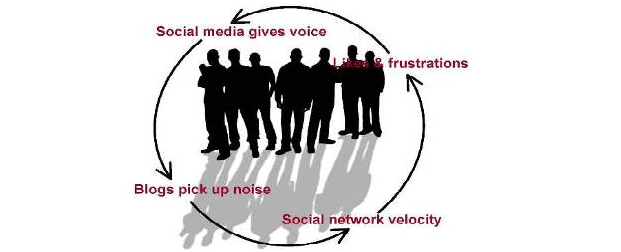I really like the word innovation it sounds so … progressive.
And with all of the data Facebook and Google gather and sell about you, you’d think we’d really see some innovative products emerge.
You know, really different, really better. Not just a knockoff with a few tweaks, lower price.
There are two smartphones – Apple, Samsung – and a hundred or so copies.
There’s one tablet – Apple – and a ton of copies/variations.
Phablets? Samsung and a growing bunch of smartphones on steroids, tablets on diets.
Rather than sweat it, I did what any red-blooded male would do … went to the movies (“Godzilla,””Wolverine”).
Suddenly, I figured out what folks meant about Big Data and innovation.
“Karate Kid?” Good movie … four sequels.
“Wolverine?” Great movie … four or five sequels.
“Godzilla?” Super movie … 8-10 sequels.
Don’t ***** with a formula that works.
Where do you see a film that is really different, really exciting/interesting?
Check out a film festival or see indie movies in out-of-the-way art theaters.
It’s not your standard fare and it plays with your senses.
Not long ago, I met Cirina Catania, the head of The Catania Group, and saw a few of her films. She has been volunteering her talents to produce documentaries for non-profits including After Action, Furnishing Hope and other projects focusing on wounded (physically and mentally) service personnel who are rebuilding their lives.
Moving Documentaries – Marine veteran Kionte Storey found a new purpose after being wounded during his deployment in Afghanistan and now trains every day on the track at UCSD, hoping to place on the Paralympic track team in the two years. Cirina Catania, filmmaker and founder of The Catania Group, has made it one of her cinematographic missions to document his return journey as he trains nearly non-stop. She is focused on telling the tale of Storey’s efforts and those of other veterans in film. Creative works like these don’t get made by big studios.
Sometimes they are sleeping on air mattresses in empty apartments (or worse) and seeing volunteers turn bare rooms into comfortable living spaces in a day for them and their families has been an inspiration to many.
Catania would like to see her projects picked up by a television network so she can share these stories with audiences worldwide. It might happen, but it’s a little edgy and uncomfortable for a prime time series.
Face it, that makes networks and big studios worry because they want no-brainer formula “reality” shows that bring in big dollars.
It takes an indie with fire in the gut, the eye of the tiger and a hunger to tell his/her story.
You know, say to hell with the sequel mode and do something he/she thinks people have to see/want to see.
The same is true of our industry.
Apple has had a decent string of box office hits.
Competitors look at the Big Data (sales), media noise and say that’s what the consumer really wants … do it!
Path to Innovation – While consumers wring their hands and worry about companies (and governments) tracking their every move, every click; they can probably forget about how much attention big data efforts are about them. Management spends more time tracking what the competition is doing and how their products are faring in the marketplace.
All they have to do is make a thing that looks kinda’ like the winners folks are buying and add a little “innovation” (make enough changes to avoid a string of lawsuits).
Don’t get me wrong, there are a lot of excellent designers, developers and engineers doing some exciting things inside companies that can and hopefully will make a difference for us.
They’ve made significant enhancements in technology and products.
They’re recognized by their peers but often go unheralded for their breakthroughs.
Sometimes they and their teams even deliver a product/solution that changes the way we work, play.
Faster Adoption – With data and information coming at us 24×7 on a global basis, people want newer products, newer technology as quickly as possible. Today’s “new” products quickly move from the innovators to the laggards.
- But the winners weren’t based on big data because:
- The products I mentioned were breaks from the past and it’s hard to tell folks what you will want if it hasn’t been offered yet.
All of that data was gathered by machines which (currently) don’t have the capability to extract insights and make informed or gut-level decisions on what the consumer wants or may want.
Data Storm – Today, companies and analytic firms have data coming at them from nearly every direction. When it sweeps over you, sometimes it’s difficult to see where your goal is or where it went. Volume isn’t always a good thing.
No, it was a CEO, COO or CMO who was just a little smarter about his/her business than the competition … and listened to what the consumer said and/or didn’t say.
They dig through the data with picks and shovels to make a go/no-go decision.
Going out on a limb to gamble on tomorrow takes guts, immense self-confidence/ego or a guy/gal who owns most of the company stock so he/she isn’t worried about having a job.
The indie product/service developer, designer, marketer is different.
He/she doesn’t have much to lose.
He/she has already maxed out the credit cards, borrowed from mom/dad/every friend/relative and may even be sleeping on a friend’s couch.
Breaking Down Barriers – Start-ups in any field are willing to risk it all to break down conventional thinking and technological barriers. The financial rewards are nice (O.K., great) but the satisfaction of knowing you made a difference is what makes engineers and designers get up every day and face the new challenges.
The individual simply wants to (admit it, they often feel they have to) break down the barriers of the norm and ignore the data-driven algorithms to take the human approach to a problem the ones and zeros don’t see, can’t even imagine.
In creating an original film, an original work, an aha! product, a fresh insight seldom comes from precise calculation.
Good, even great, products and services emerge from a messy process, a little eureka!, serendipity and a touch of insanity.
The popular idea that the industry can replace human judgment with algorithmic efficiency and deliver the profits companies/shareholders want and need in combination with what the consumer wants/needs doesn’t deliver what companies say is their core differentiator … innovation.
At a time when every technical innovation quickly becomes a cheap commodity, it is becoming even more difficult for the early pioneers to stay ahead of the crowd.
The challenge is for the established firms to eliminate obstacles so engineers/designers/developers can stay ahead of the start-up with nothing to lose.
Big Data is useful and important if we’re going to improve our understanding of ourselves and the world. It’s important for businesses and governments to improve their decision-making and be globally competitive.
Quant Heaven – Analysts love the depth, breadth of data that huge data centers can tap into and turn out for them. They know that somewhere in there – somewhere – there’s just the answer they need to prove their data is better than your data.
The challenge is that the gatherers need a strategic plan to take advantage of Big Data instead of just gathering it because everyone else is and they can, as well.
At least Amazon puts their Big Data to work for customers by putting targeted information in front of a customer based on his/her browsing or purchase interest areas. It’s not really intrusive (O.K., maybe a little scary) but they offer suggestions you might find of interest/assistance.
Brands like Zappos, Netflix and OWC/macsales use their smart data to empower sales/support people to assist customers with purchase questions, problems/issues. It enables the organization to have better, more satisfying conversations with people they know – at least their history and interaction with the company – to help them find the solution and leave satisfied.
Creativity/innovation is impossible to quantify, but as most humans say, “I know it when I see it.”
It’s tempting to think that Big Data will deliver the answer without human intervention that goes against “documented facts.”
It takes guts, commitment, luck and a helluva’ lot of hard work to make your film, product, service stand out from the crowd.




